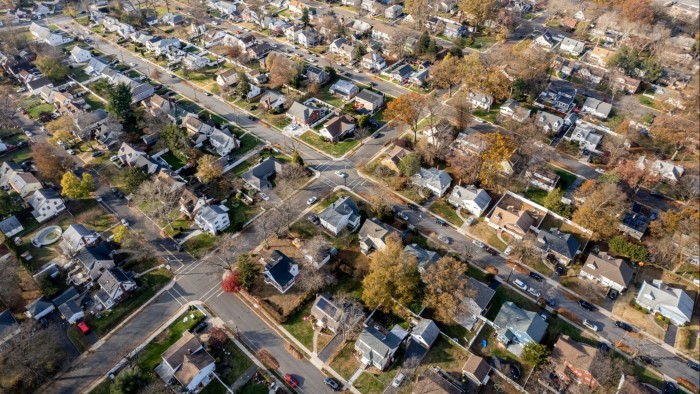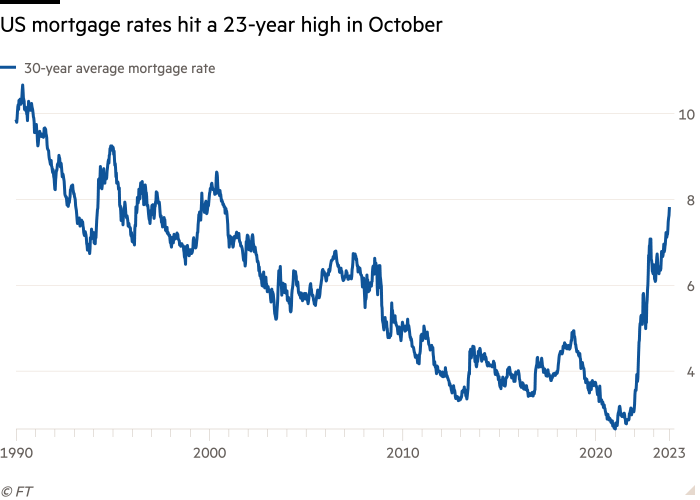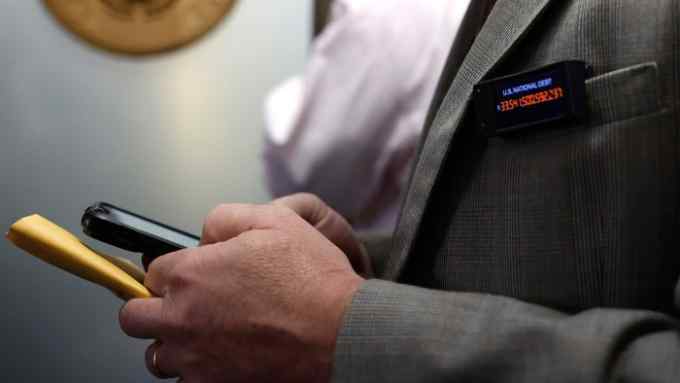Mortgage-backed securities market waits for interest rate clouds to lift

Roula Khalaf, Editor of the FT, selects her favourite stories in this weekly newsletter.
At ABS East, a big gathering for the securitisation markets in Miami last month, both the mood and the weather were better than expected, attendees said. But in the beleaguered subsector of mortgage-backed securities (MBS), seeing just a glimmer of sunshine is about as good as it has got this year. And the forecast seems unlikely to improve any time soon.
With $12.2tn-worth of bonds outstanding, the US MBS market ranks second in size only to that for US Treasuries — which is on course for an unprecedented third year of losses as interest rates have risen, forcing prices down, in order to deliver the competitive yields that investors require.
Given that they comprise bundles of home loans, mortgage-backed securities move to roughly the same macroeconomic impulses as Treasuries. However, their performance and outlook have been further hurt by big cuts in both their supply and demand.
On top of that, market participants must factor in the travails of the US housing market, as homeowners struggle with interest rates that seem set to stay higher for longer than many analysts expected.
Still, at the ABS East event in Florida, “the sentiment . . . was encouraging, and the cheapness [of MBS] was unanimous across all our meeting discussions”, observed strategists from Bank of America. They described the mood for MBS as one of “cautious optimism”.
But there remain plenty of reasons why investors may wish to lean more towards caution.
More than a year ago, one of the three big buyers of MBS — the US Federal Reserve — began a slow but steady withdrawal from the market, and it shows no sign of changing course. This year, interest from another equally important set of buyers — bank treasuries with excess deposits to invest — also declined as customer inflows stopped and, in some cases, fell.
That has left one big group of buyers — institutional investors and money managers — alone in supporting the MBS market.
“The market is cheap, but it’s been cheap all year and it’s stayed there,” says Ken Shinoda, portfolio manager at DoubleLine. “When might buyers step back in? [When] either banks stop losing deposits and need to invest, or investors think the Fed’s about to cut rates and they want to lock in yields out the curve.
“If money comes back in and there is demand — whether it’s [from] banks, institutional investors or money managers seeing bond fund inflows — that could help to drive spreads tighter.”
Spreads are the premium over US Treasury yields that investors require to justify holding MBS, and they have risen sharply in the past two years. Currently, for top-rated MBS backed by the US government, they stand at almost 1.8 percentage points, according to Bloomberg data. That’s below a peak of 1.9 percentage points in May, but well up from 0.6 percentage points in January 2022.
For these spreads to fall, MBS prices would have to rise more rapidly than Treasury prices — which would then encourage fresh investment.
Supply, at least, is likely to remain relatively tight, offering some support to MBS prices. That is because the flow of new home loans to back new MBS issuance has all but dried up as American homeowners blanch at mortgage rates approaching 8 per cent — the highest level in at least two decades.
Unlike homebuyers in most other countries, including the UK, buyers in the US tend to take out 30-year fixed-rate loans — which means they are typically keen to buy homes or to refinance, thereby creating new mortgages, when interest rates fall.
However, with roughly three-quarters of homeowners currently paying rates of 4 per cent or less on their home loans, few are prepared to give those up and move. This reduces the stock of houses for sale, and the number of mortgage applications.

Kirill Krylov, MBS portfolio strategist at investment bank Baird, says this has helped create “a perfect recipe for a lukewarm production of new mortgage-backed securities”. He adds: “We’re also coming into winter months — a seasonal low point in home purchases, since fewer prospective buyers are interested in moving during a school year.”
Krylov estimates net MBS issuance will reach about $238bn this year — the second lowest reading in eight years and a far cry from the $852bn of net new supply in 2021, before interest rates began to rise.
“The US also ‘borrowed forward’ so much housing demand during the pandemic when mortgage rates fell, and that’s also depressing appetite now,” he explains.
According to Citigroup analysts, the affordability gap — a measure of the difference between actual house prices and what calculations suggest buyers can afford — is near its widest level ever.
“Home prices would have to fall about 33 per cent to restore the equilibrium,” says James DeSorbo, an analyst at Citigroup, who notes that this was last seen in early 2022. “Alternatively, mortgage rates would have to rally [fall] back to 3.5 per cent.”
Tellingly, the MBS market received very little attention in Florida last month, despite its size. Conference attendees were far keener to discuss hotter topics, such as the role private credit might play in other asset-backed markets. Until something shifts in the housing market, any response beyond very cautious optimism will probably be hard to come by.

Comments